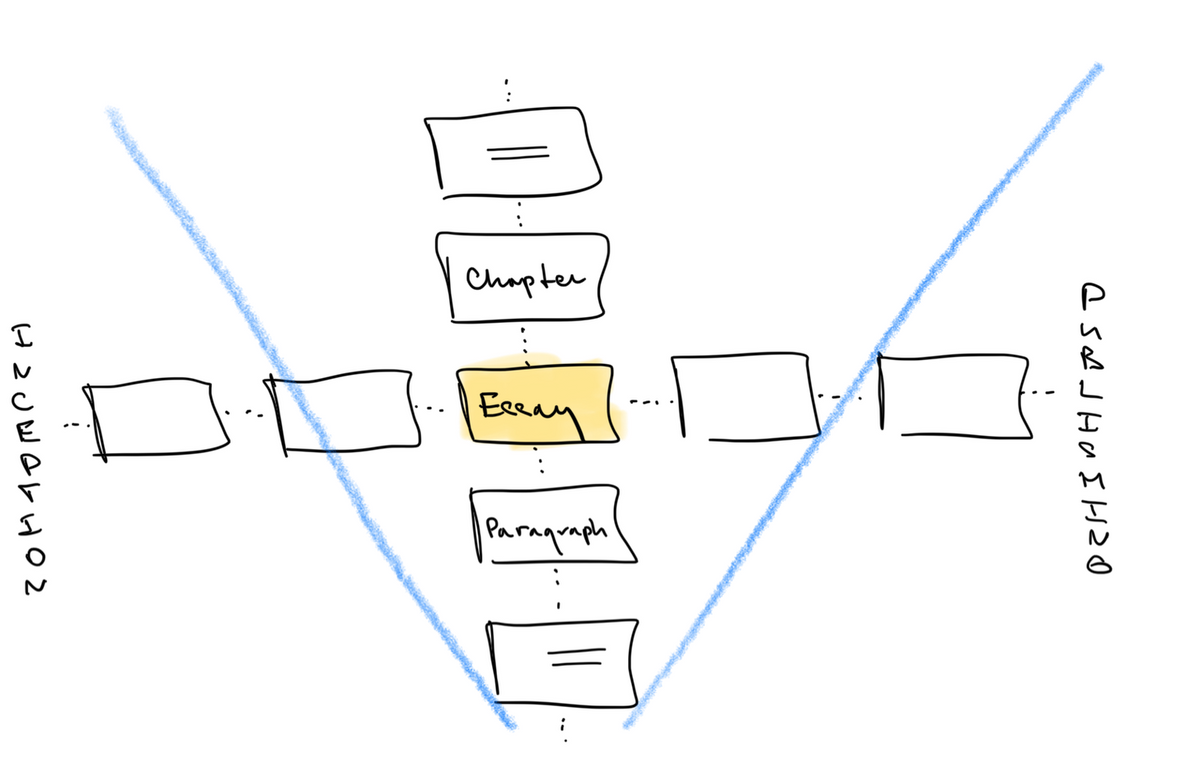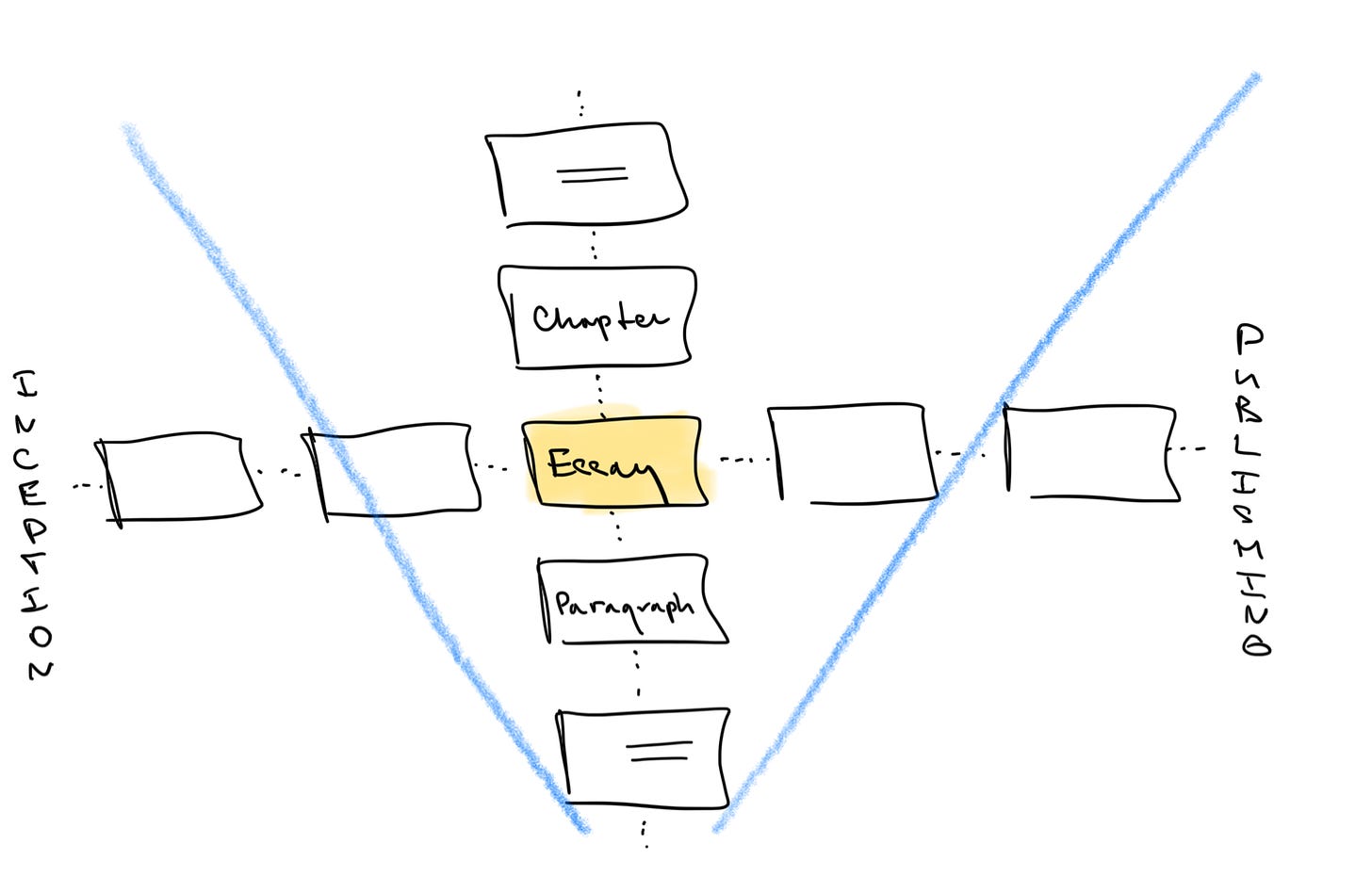The writing matrix
How to transform a vague idea into a structured outline in less than 10 minutes.

In this post, I cover my writing method to transform a vague idea into a structured outline in less than 10 minutes. If you’ve got something to write this week, it’s a good place to start from.
Table of contents:
- The creativity distortion; three reasons why we think about creativity wrong
- Writing is thinking; when you sit down to write you need to have already thought
- The writing matrix; visualize the density and time dimensions of an idea and ask a sequence of questions to pull out a natural structure from your head
- Beyond writing; how the writing matrix helps to solve creative problems
Enjoy your reading.
The distorted view of creativity
Everybody writes. But for most people, writing is a struggle. They stare at a blinking cursor for hours and don’t hear a thing.
That’s because people think about creativity wrong. They believe creativity is some voodoo magic plus innate genius. It’s this brilliant idea that strikes you when you’re wandering around dark Edinburgh streets and see a boy with round eyeglasses, and you scream and run back and write Harry Potter at one go.

Why we think of creativity that way?
First, because journalists love it. Their jobs are to write what people read, and people strive for blood and sweat and tears. And if you give a journalist a story of Thomas Edison who failed ten thousand times but then finally figured out a major invention, they’ll scream with joy. But if you tell a journalist that you just thought through the problem, they’ll stare at you with a lame look. “People won’t click.” And if you consider that most humans receive information through journalism in one form or another, it becomes obvious why we think of creativity as a spark of inspiration—the incentives of journalists are screwed up to write about stories that feel inspiring.
The second reason is that most creative work actually gets done that way. I’ve been wondering why for a long time but haven’t found a good answer. For some reason, it’s just hard for people to accept that there might be a better way to think instead of staring at a blank page for days. Tesla once said about Edison that if he had to find a needle in a haystack, he’d spent years taking the whole thing down piece by piece instead of burning the hay in five minutes.
Lastly, hoping for a creative miracle takes the responsibility off your shoulders. It’s way easier to believe in creativity than in knowledge; to assume that creativity is some random event that cannot be controlled in any way whatsoever. Because if you fail, that’s not your fault. That’s why students love wearing t-shirts with Einstein’s quote that creativity is more important than intelligence. They don’t bother looking up Einstein’s work and seeing if he had said something else to say on the matter. Most of them don’t even know who Einstein was.
The writing matrix
Misunderstanding of creativity explains why people face difficulties with writing. They think writing is when you sit down in front of a computer, open a new Word document, start typing—and boom, a few hours later, you’ve got a good piece of work.
But writing is actually thinking. To write something down, you need to have already thought what you’re going to say. That’s why people struggle so much to put words on a page; they haven’t thought through the idea [1].
Here’s the method I use to transform vague ideas into structured outlines.
Let’s say you’ve got an idea for an essay.
The first thing to do is to discard your belief that it’s an idea for an essay. Because an essay is a form, and the form must always meet the function. And if you’ve got a one-sentence dense idea, you don’t need an essay to communicate it to the world; a tweet will do. Unfortunately, most writers don’t follow this advice. That’s why we end up having 200-pages long NYT bestsellers covering one thought that could be explained with half a page of dense text.
To avoid producing fluffy prose, I designed a matrix for developing thoughts.

On the vertical axis, there’s a hierarchy of ideas by density. The layers are a sentence, a paragraph, half page, a page, a section, a chapter, a book, etc. Anything from a few words to 3 million characters in Anna Karenina.
On the horizontal dimension, I’ve got time. The process begins with the very inception of an idea to the moment it’s published. Note that for different layers of density, the time dimension is different as well (blue lines); it increases with the complexity of an idea itself. It will take a few minutes to express a sentence-long idea as a tweet and years to write a good 500-pages book.
Here’s a two-step algorithm I follow when I get an idea for writing.
First, I ask myself:
“What’s the density range of this idea?”
Usually, it’s hard to answer this question precisely because an idea is not fully formed yet. As Picasso said, you must begin drawing to start seeing the painting. But you must start from somewhere, and that’s why it’s useful to answer imprecisely; the range provides a rough understanding of what an idea is about. If you have trouble at this step and it’s hard to define even an imprecise range, change the question to an affirmative conclusion of the lowest density. Just tell yourself, “OK, let’s suppose this idea I’m thinking about is a paragraph-dense idea,” and proceed to the next step.
Second, I ask:
“Why do I think so?”
I try to be specific:
- “Why do I think this is a paragraph-dense idea?”
- “Why do I think it will take a page?”
This question pulls out the natural structure of an idea from my head [2]. I immediately hear things like: “Oh that’s because I need to explain such and such, and then I also need an introduction, and then…” I jot down the structure and begin elaborating on each part.
How the writing matrix helps to solve creative problems
You might have already guessed that the matrix applies to many things besides prose.
Let’s take problem-solving as an example. When you start on a problem, you don’t yet know the solution. But you can imagine the answer to the problem written down on a page as text. You can then apply the same density matrix to restructure your thought and pull out relevant information from your head; information that’s already there but hard to reach.
To do that, you ask the same questions:
- “What’s the density range for the solution to this problem written on a page?”
- “Could it be a paragraph-dense?”
- “Why so?”
This might work for any problem where an outcome can be turned into a knowledge artifact and then worked backwards through the matrix:
- Email. “Let’s assume this email is one sentence dense. Why so?”
- Industry report. “Let’s suppose this report is paragraph-dense. Why do I think so?”
- Facebook post. “OK, I think it’s a sentence-dense post. Why?
That’s how you get pointers to navigate your thought. You won’t see the whole thing, but you’ll start thinking, “Oh, it’s not a paragraph-dense solution because it has to include such and such..” And “such and such” is precisely what you need to get unstuck [3].
Now make yourself smarter.
If you go through the questions below, you will reap the most benefits of reading and create new neurons in your head through neurogenesis. Otherwise, you’ll forget about 80% of what you just read tomorrow. Don’t waste time.
- What are the three reasons why people think about creativity wrong?
- Why you have to discard your idea for an essay?
- What the writing matrix is about?
- What are the two questions you need to ask to pull out a structure of an idea from your head?
- How the writing matrix helps to solve creative problems?
Write well,
Vasili
[1] Writing is like running; it always hurts to start. But if you’ve been running for a while, you know that it will get easier after the first ten minutes. You’re less scared of the suck part because you know the process. It’s the same with writing. If you know how a text evolves, you’re not scared to produce a shitty first draft and put it away for a few days. You’re confident because you know precisely where to begin, what to do, and what comes next. And this makes you excited to try new things and write more.
[2] The matrix method won’t work if you haven’t thought about the topic for a while already. It’s more focused on defining the structure than on coming up with ideas. I didn’t include the ideation part of writing in this essay because it goes beyond this work’s scope.
[3] If you’re still struggling, let it go. Write something else that you’re excited about. Or go back to thinking backwards and start from the purpose of the work—answer why you’re writing this in the first place and for who.